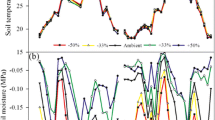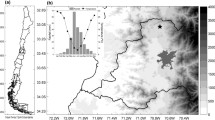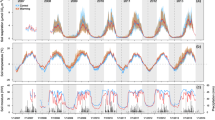Abstract
Understanding the response of ecosystem respiration (ER) to major environmental drivers is critical for estimating carbon sequestration and large-scale modeling research. Temperature effect on ER is modified by other environmental factors, mainly soil moisture, and such information is lacking for switchgrass (Panicum virgatum L.) ecosystems. The objective of this study was to examine seasonal variation in ER and its relationship with soil temperature (T s) and moisture in a switchgrass field. ER from the nighttime net ecosystem CO2 exchange measurements by eddy covariance system during the 2011 and 2012 growing seasons was analyzed. Nighttime ER ranged from about 2 (early growing season) to as high as 13 μmol m−2 s−1 (peak growing period) and showed a clear seasonality, with low rates during warm (>30 °C) and dry periods (<0.20 m3 m−3 of soil water content). No single temperature or moisture function described variability in ER on the seasonal scale. However, an exponential temperature–respiration function explained over 50 % of seasonal variation in ER at adequate soil moisture (>0.20 m3 m−3), indicating that soil moisture <0.20 m3 m−3 started to limit ER. Due to the limitation of soil–atmosphere gas exchange, ER rates declined markedly in wet soil conditions (>0.35 m3 m−3) as well. Consequently, both dry and wet conditions lowered temperature sensitivity of respiration (Q 10). Stronger ER–T s relationships were observed at higher soil moisture levels. These results demonstrate that soil moisture greatly influences the dynamics of ER and its relationship with T s in drought prone switchgrass ecosystems.







Similar content being viewed by others
References
Schimel DS, House JI, Hibbard KA, Bousquet P, Ciais P, Peylin P et al (2001) Recent patterns and mechanisms of carbon exchange by terrestrial ecosystems. Nature 414(6860):169–172
Davidson EA, Janssens IA, Luo Y (2006) On the variability of respiration in terrestrial ecosystems: moving beyond Q10. Glob Change Biol 12:154–164
Flanagan LB, Johnson BG (2005) Interacting effects of temperature, soil moisture and plant biomass production on ecosystem respiration in a northern temperate grassland. Agric For Meteorol 130:237–253
Gifford RM (2003) Plant respiration in productivity models: conceptualisation, representation and issues for global terrestrial carbon-cycle research. Funct Plant Biol 30:171–186
Lloyd J, Taylor JA (1994) On the temperature dependence of soil respiration. Funct Ecol 8:315–323
Schimel DS, Braswell BH, Holland EA, McKeown R, Ojima DS, Painter TH et al (1994) Climatic, edaphic, and biotic controls over storage and turnover of carbon in soils. Glob Biogeochem Cycles 8:279–293
Baldocchi D, Bernhofer C, Anthoni P, Evans R, Davis K, Running S et al (2001) FLUXNET: A new tool to study the temporal and spatial variability of ecosystem-scale carbon dioxide, water vapor, and energy flux densities. Bull Amer Meteor Soc 82:2415–2434
Moncrieff JB, Malhi Y, Leuning R (1996) The propagation of errors in long-term measurements of land–atmosphere fluxes of carbon and water. Glob Change Biol 2:231–240
Davidson E, Belk E, Boone RD (1998) Soil water content and temperature as independent or confounded factors controlling soil respiration in a temperate mixed hardwood forest. Glob Change Biol 4:217–227
Qi Y, Xu M (2001) Separating the effects of moisture and temperature on soil CO2 efflux in a coniferous forest in the Sierra Nevada mountains. Plant Soil 237(1):15–23
Barr AG, Fuentes JD, Chen Z, Morgenstern K, Staebler RM, Griffis TJ et al (2002) Comparing the carbon budgets of boreal and temperature deciduous forest stands. Can J For Res 32:813–822
Black TA, Den HG, Neumann HH, Blanken PD, Yang PC, Russell C et al (1996) Annual cycles of water vapour and carbon dioxide fluxes in and above a boreal aspen forest. Glob Change Bioenergy 2:219–229
Wagle P, Kakani VG (2013) Seasonal variability in net ecosystem carbon dioxide exchange over a young Switchgrass stand. Glob Chang Biol Bioenergy doi:10.1111/gcbb.12049
Reichstein M, Rey A, Freibauer A, Tenhunen J, Valentini R, Banza J et al (2003) Modeling temporal and large-scale spatial variability of soil respiration from soil water availability, temperature and vegetation productivity indices. Glob Biogeochem Cycles 17:15.1–15.15
Wen XF, Yu GR, Sun XM, Li QK, Liu YF, Zhang LM et al (2006) Soil moisture effect on the temperature dependence of ecosystem respiration in a subtropical Pinus plantation of southeastern China. Agric For Meteorol 137:166–175
Liu X, Wan S, Su B, Hui D, Luo Y (2002) Response of soil CO2 efflux to water manipulation in a tallgrass prairie ecosystem. Plant Soil 240:213–223
Xu L, Baldocchi DD (2004) Seasonal variation in carbon dioxide exchange over a Mediterranean annual grassland in California. Agric For Meteorol 123:79–96
Flanagan LB, Carlson PJ, Wever LA (2002) Seasonal and interannual variation in carbon dioxide exchange and carbon balance in a northern temperate grassland. Glob Change Biol 8:599–615
Xu L, Baldocchi DD, Tang J (2004) How soil moisture, rain pulses, and growth alter the response of ecosystem respiration to temperature. Glob Biogeochem Cycles 18, GB4002
Gao Y, Li X, Liu L, Jia R, Yang H, Li G et al (2012) Seasonal variation of carbon exchange from a revegetation area in a Chinese desert. Agric For Meteorol 156:134–142
Huxman TE, Cable JM, Ignace DD, Eilts JA, English NB, Weltzin J et al (2004) Response of net ecosystem gas exchange to a simulated precipitation pulse in a semi-arid grassland: the role of native versus non-native grasses and soil texture. Oecologia 141:295–305
Borken W, Xu YJ, Brumme R, Lamersdorf N (1999) A climate change scenario for carbon dioxide and dissolved organic carbon fluxes from a temperate forest soil: drought and rewetting effects. Soil Sci Soc Am J 63:1848–1855
Howard DM, Howard PJA (1993) Relationships between CO2 evoluation, moisture content and temperature for a range of soil types. Soil Biol Biochem 25:1537–1546
Skopp J, Jawson MD, Doran JW (1990) Steady-state aerobic microbial activity as a function of soil water content. Soil Sci Soc Am J 54:1619–1625
Singh JS, Gupta SR (1977) Plant decomposition and soil respiration in terrestrial ecosystems. Bot Rev 43:449–528
Boone RD, Nadelhoffer K, Canary JD, Kaye JP (1998) Roots exert a strong influence on the temperature sensitivity of soil respiration. Nature 396:570–572
Niu S, Luo Y, Fei S, Yuan W, Schimel D, Law BE et al (2012) Thermal optimality of net ecosystem exchange of carbon dioxide and underlying mechanisms. New Phytol 194:775–783
Janssens IA, Pilegaard KIM (2003) Large seasonal changes in Q 10 of soil respiration in a beech forest. Glob Change Biol 9:911–918
Liski J, Ilvesniemi H, Mäkelä A, Westman CJ (1999) CO2 emissions from soil in response to climatic warming are overestimated: the decomposition of old soil organic matter is tolerant of temperature. Ambio 28:171–174
Raich JW, Schlesinger WH (1992) The global carbon dioxide flux in soil respiration and its relationship to vegetation and climate. Tellus B 44:81–99
Kirschbaum MUF (1995) The temperature dependence of soil organic matter decomposition, and the effect of global warming on soil organic C storage. Soil Biol Biochem 27:753–760
Ewel KC, Cropper WP Jr, Gholz HL (1987) Soil CO2 evolution in Florida slash pine plantations: I. Changes through time. Can J For Res 17:325–329
Ma Z, Wood CW, Bransby DI (2000) Soil management impacts on soil carbon sequestration by switchgrass. Biomass Bioenergy 18:469–477
Acknowledgments
This study was funded by USDA–NIFA through Biomass Research and Development Initiative (BRDI), a joint effort between the U.S. Department of Agriculture (USDA) and the U.S. Department of Energy (DOE). This paper is a contribution of the Oklahoma Agricultural Experiment Station, Oklahoma State University, Stillwater, OK.
Author information
Authors and Affiliations
Corresponding author
Rights and permissions
About this article
Cite this article
Wagle, P., Kakani, V.G. Confounding Effects of Soil Moisture on the Relationship Between Ecosystem Respiration and Soil Temperature in Switchgrass. Bioenerg. Res. 7, 789–798 (2014). https://doi.org/10.1007/s12155-014-9434-8
Published:
Issue Date:
DOI: https://doi.org/10.1007/s12155-014-9434-8




